Attached files
| file | filename |
|---|---|
| 8-K - FORM 8-K - M&T BANK CORP | d453583d8k.htm |
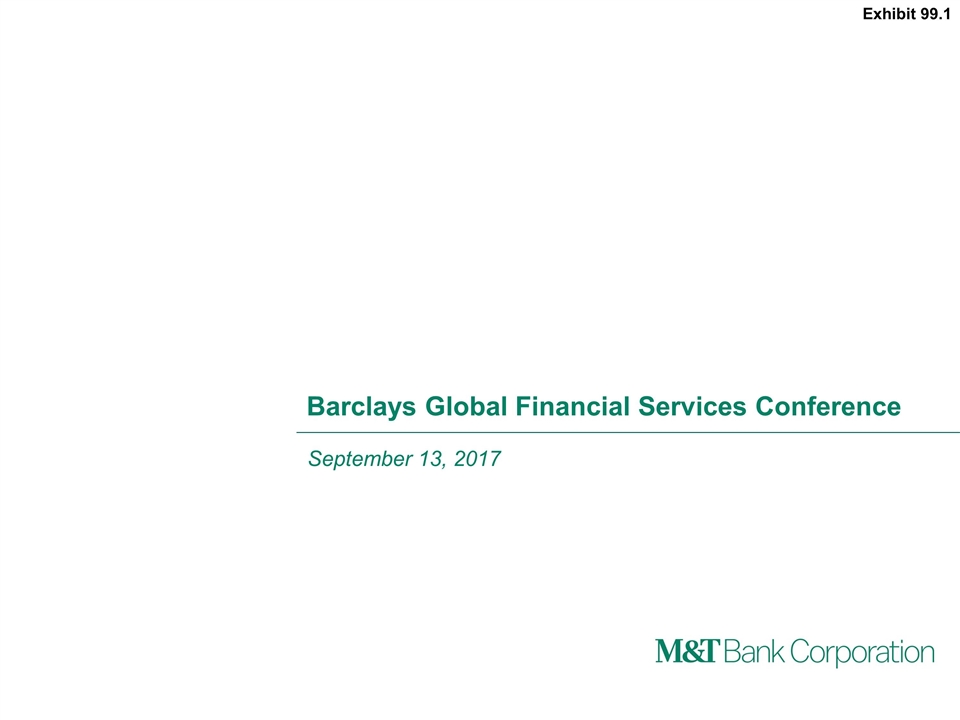
Barclays Global Financial Services Conference September 13, 2017 Exhibit 99.1
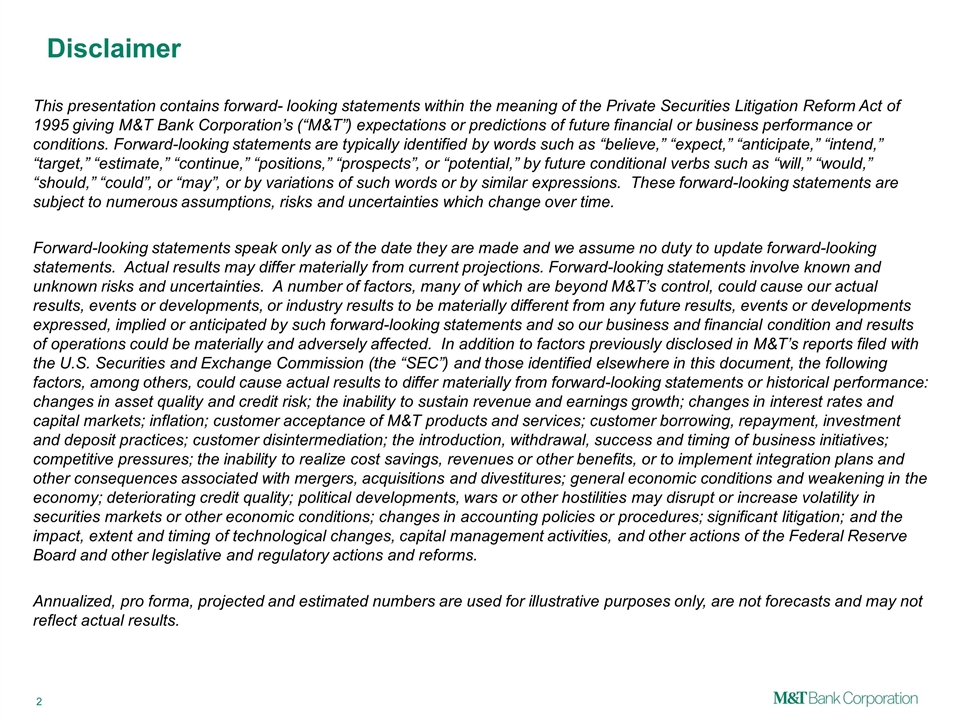
Disclaimer This presentation contains forward- looking statements within the meaning of the Private Securities Litigation Reform Act of 1995 giving M&T Bank Corporation’s (“M&T”) expectations or predictions of future financial or business performance or conditions. Forward-looking statements are typically identified by words such as “believe,” “expect,” “anticipate,” “intend,” “target,” “estimate,” “continue,” “positions,” “prospects”, or “potential,” by future conditional verbs such as “will,” “would,” “should,” “could”, or “may”, or by variations of such words or by similar expressions. These forward-looking statements are subject to numerous assumptions, risks and uncertainties which change over time. Forward-looking statements speak only as of the date they are made and we assume no duty to update forward-looking statements. Actual results may differ materially from current projections. Forward-looking statements involve known and unknown risks and uncertainties. A number of factors, many of which are beyond M&T’s control, could cause our actual results, events or developments, or industry results to be materially different from any future results, events or developments expressed, implied or anticipated by such forward-looking statements and so our business and financial condition and results of operations could be materially and adversely affected. In addition to factors previously disclosed in M&T’s reports filed with the U.S. Securities and Exchange Commission (the “SEC”) and those identified elsewhere in this document, the following factors, among others, could cause actual results to differ materially from forward-looking statements or historical performance: changes in asset quality and credit risk; the inability to sustain revenue and earnings growth; changes in interest rates and capital markets; inflation; customer acceptance of M&T products and services; customer borrowing, repayment, investment and deposit practices; customer disintermediation; the introduction, withdrawal, success and timing of business initiatives; competitive pressures; the inability to realize cost savings, revenues or other benefits, or to implement integration plans and other consequences associated with mergers, acquisitions and divestitures; general economic conditions and weakening in the economy; deteriorating credit quality; political developments, wars or other hostilities may disrupt or increase volatility in securities markets or other economic conditions; changes in accounting policies or procedures; significant litigation; and the impact, extent and timing of technological changes, capital management activities, and other actions of the Federal Reserve Board and other legislative and regulatory actions and reforms. Annualized, pro forma, projected and estimated numbers are used for illustrative purposes only, are not forecasts and may not reflect actual results.
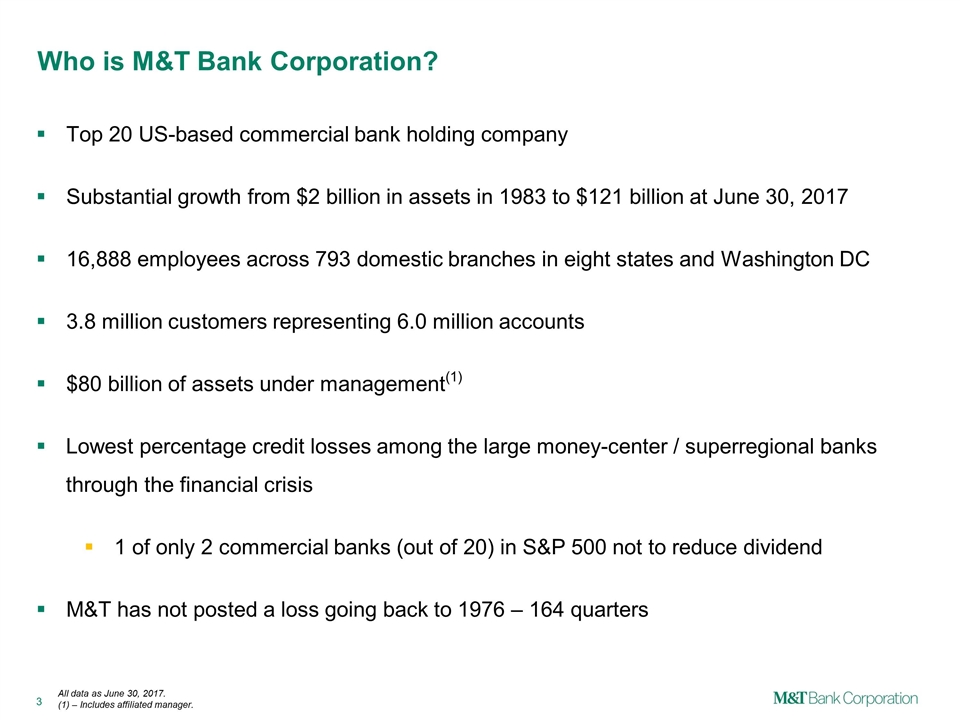
Who is M&T Bank Corporation? Top 20 US-based commercial bank holding company Substantial growth from $2 billion in assets in 1983 to $121 billion at June 30, 2017 16,888 employees across 793 domestic branches in eight states and Washington DC 3.8 million customers representing 6.0 million accounts $80 billion of assets under management(1) Lowest percentage credit losses among the large money-center / superregional banks through the financial crisis 1 of only 2 commercial banks (out of 20) in S&P 500 not to reduce dividend M&T has not posted a loss going back to 1976 – 164 quarters All data as June 30, 2017. (1) – Includes affiliated manager.
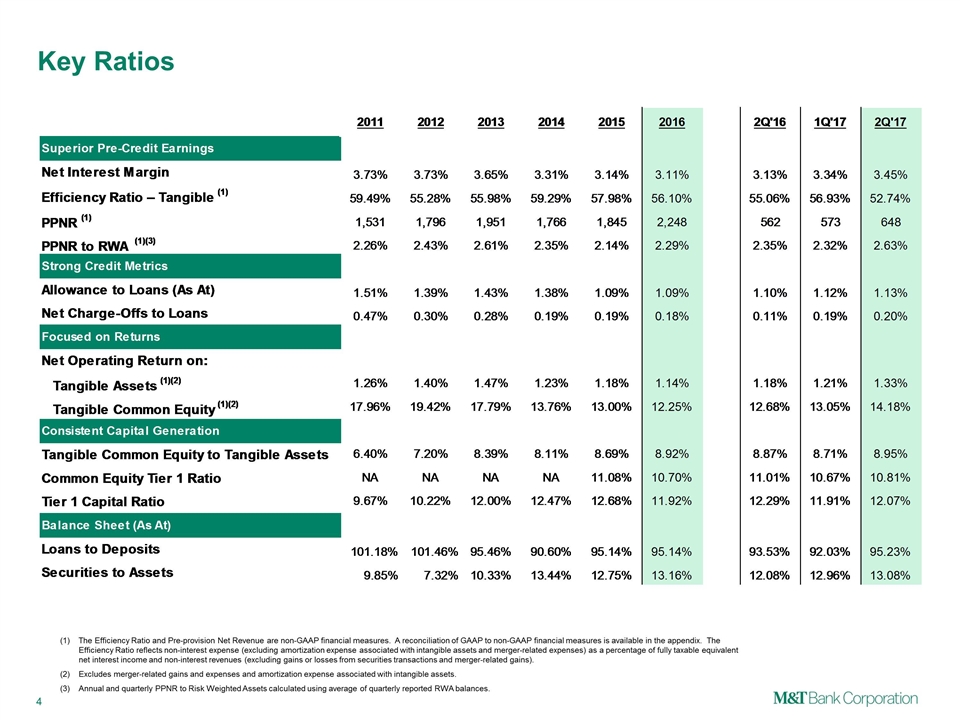
Key Ratios The Efficiency Ratio and Pre-provision Net Revenue are non-GAAP financial measures. A reconciliation of GAAP to non-GAAP financial measures is available in the appendix. The Efficiency Ratio reflects non-interest expense (excluding amortization expense associated with intangible assets and merger-related expenses) as a percentage of fully taxable equivalent net interest income and non-interest revenues (excluding gains or losses from securities transactions and merger-related gains). Excludes merger-related gains and expenses and amortization expense associated with intangible assets. Annual and quarterly PPNR to Risk Weighted Assets calculated using average of quarterly reported RWA balances.

M&T’s Business Model – a Historical Perspective Years prior to 2011 not restated for LIHTC. Refer to appendix for peer group list and GAAP reconciliation.
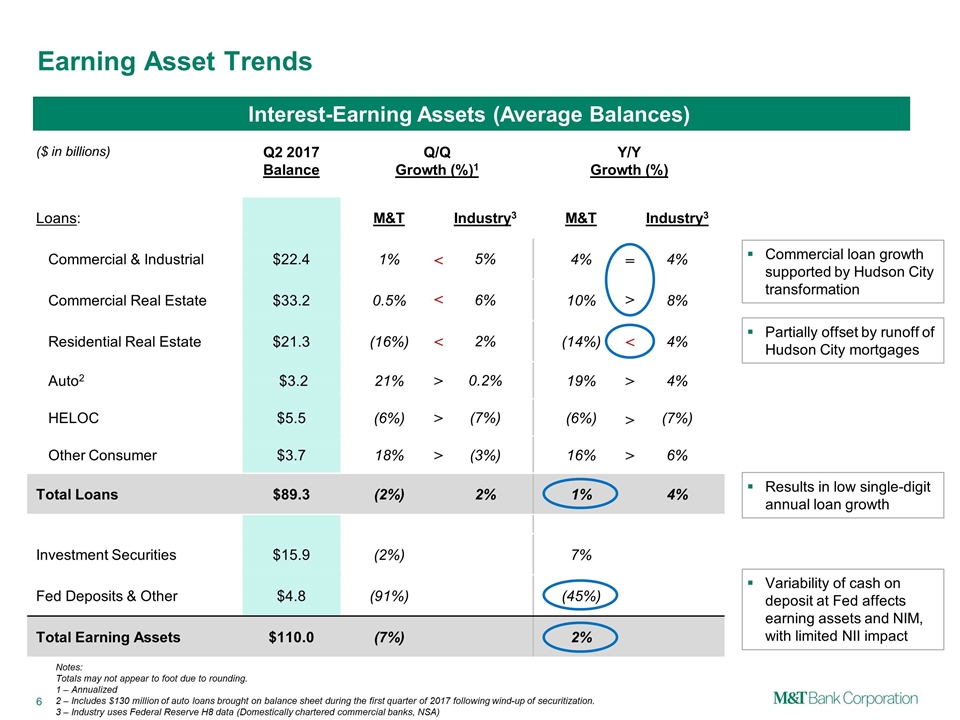
Earning Asset Trends Interest-Earning Assets (Average Balances) ($ in billions) Q2 2017 Balance Q/Q Growth (%)1 Y/Y Growth (%) Loans: M&T Industry3 M&T Industry3 Commercial & Industrial $22.4 1% 5% 4% 4% Commercial Real Estate $33.2 0.5% 6% 10% 8% Residential Real Estate $21.3 (16%) 2% (14%) 4% Auto2 $3.2 21% 0.2% 19% 4% HELOC $5.5 (6%) (7%) (6%) (7%) Other Consumer $3.7 18% (3%) 16% 6% Total Loans $89.3 (2%) 2% 1% 4% Investment Securities $15.9 (2%) 7% Fed Deposits & Other $4.8 (91%) (45%) Total Earning Assets $110.0 (7%) 2% Notes: Totals may not appear to foot due to rounding. 1 – Annualized 2 – Includes $130 million of auto loans brought on balance sheet during the first quarter of 2017 following wind-up of securitization. 3 – Industry uses Federal Reserve H8 data (Domestically chartered commercial banks, NSA) Commercial loan growth supported by Hudson City transformation Partially offset by runoff of Hudson City mortgages Results in low single-digit annual loan growth Variability of cash on deposit at Fed affects earning assets and NIM, with limited NII impact < < < > > = > < > > > >
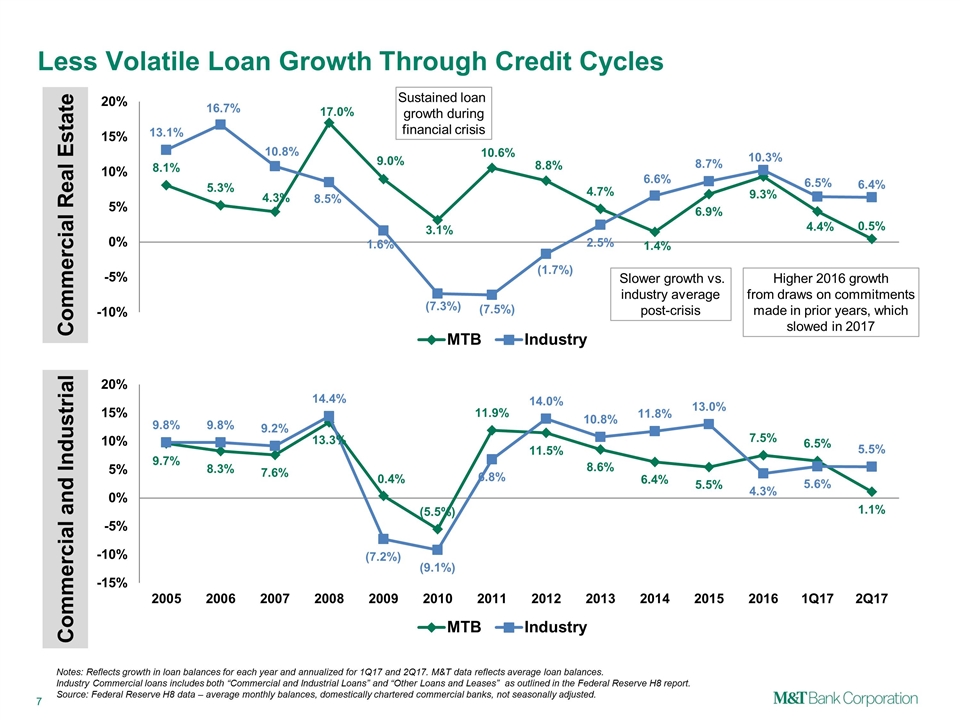
Less Volatile Loan Growth Through Credit Cycles Commercial Real Estate Commercial and Industrial Notes: Reflects growth in loan balances for each year and annualized for 1Q17 and 2Q17. M&T data reflects average loan balances. Industry Commercial loans includes both “Commercial and Industrial Loans” and “Other Loans and Leases” as outlined in the Federal Reserve H8 report. Source: Federal Reserve H8 data – average monthly balances, domestically chartered commercial banks, not seasonally adjusted. Slower growth vs. industry average post-crisis Higher 2016 growth from draws on commitments made in prior years, which slowed in 2017 Sustained loan growth during financial crisis

Core Deposit Trends – 2Q17 compared with 1Q16(1) Average total core deposits up 2.6% Consumer deposits down a net $3 billion, rates down 12 bps Higher cost Hudson City TDs maturing, rates down About 1/3 of outflows offset by higher legacy M&T balances Commercial & Business banking deposits up 2.2% Trust deposits up over $1.7 billion, large quarterly volatility due to customer activity Mortgage escrow deposits up $1.5 billion, tied to subservicing contracts (1) – First full quarter following Hudson City merger
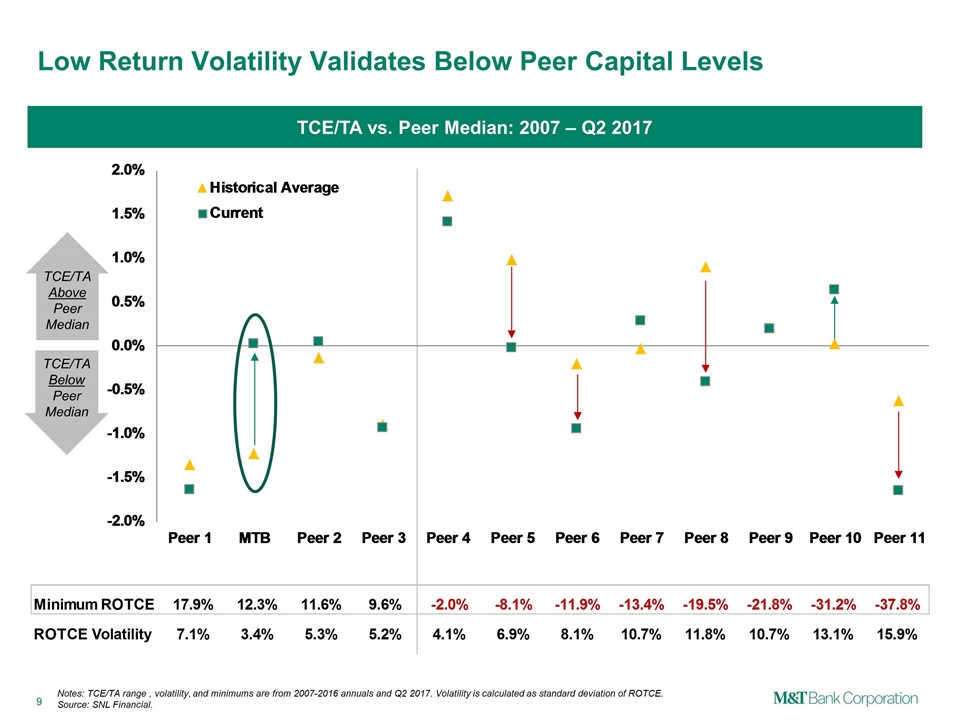
Notes: TCE/TA range , volatility, and minimums are from 2007-2016 annuals and Q2 2017. Volatility is calculated as standard deviation of ROTCE. Source: SNL Financial. TCE/TA vs. Peer Median: 2007 – Q2 2017 Low Return Volatility Validates Below Peer Capital Levels TCE/TA Above Peer Median TCE/TA Below Peer Median

Cumulative Capital Retained, Dividends and Share Repurchases Deploying Capital Where and When it Makes Sense 2003 – 2007 Pre-Crisis Note: Calculated using Net Operating Income, less preferred dividends and discount amortization – see appendix M&T has maintained a consistent approach to managing its shareholders’ capital over time Retain only capital needed to support asset growth / acquisitions with returns > cost of capital Dividends at level sustainable throughout cycle Key decisions made annually during CCAR, based on year-end outlook for earnings and loan growth Limited flexibility to adjust distributions during the year should conditions change 2008 – 2011 Crisis 2012 – 2015 New Regulatory Standards 2016 – YTD 2017 Post-Hudson City 80% 52% 35% 104% Total Payout
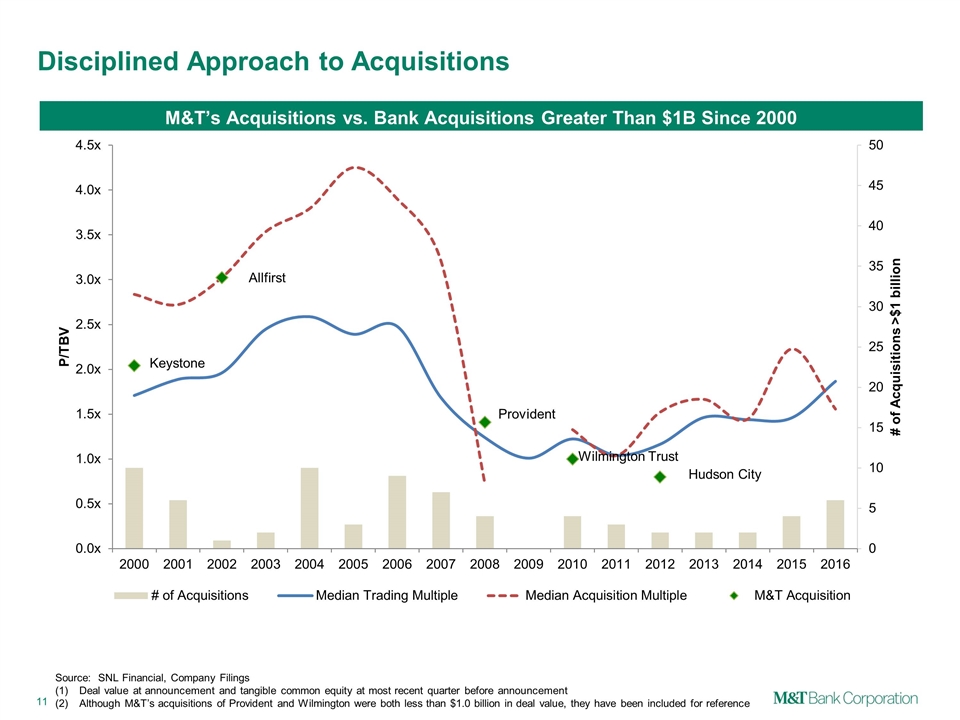
Disciplined Approach to Acquisitions Source: SNL Financial, Company Filings Deal value at announcement and tangible common equity at most recent quarter before announcement Although M&T’s acquisitions of Provident and Wilmington were both less than $1.0 billion in deal value, they have been included for reference M&T’s Acquisitions vs. Bank Acquisitions Greater Than $1B Since 2000
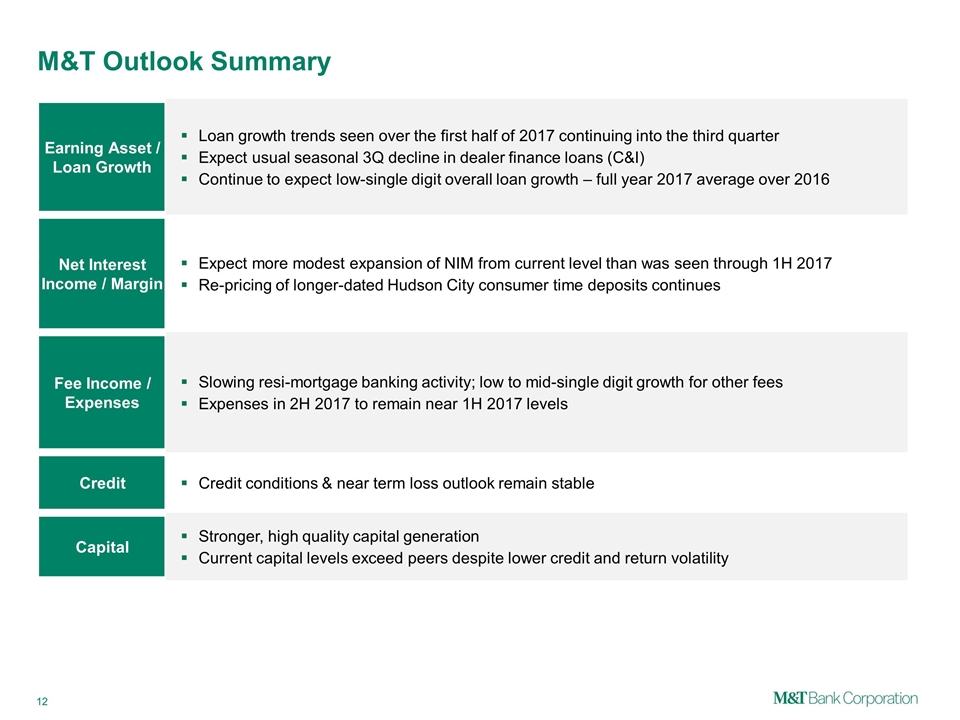
M&T Outlook Summary Earning Asset / Loan Growth Loan growth trends seen over the first half of 2017 continuing into the third quarter Expect usual seasonal 3Q decline in dealer finance loans (C&I) Continue to expect low-single digit overall loan growth – full year 2017 average over 2016 Net Interest Income / Margin Expect more modest expansion of NIM from current level than was seen through 1H 2017 Re-pricing of longer-dated Hudson City consumer time deposits continues Fee Income / Expenses Slowing resi-mortgage banking activity; low to mid-single digit growth for other fees Expenses in 2H 2017 to remain near 1H 2017 levels Credit Credit conditions & near term loss outlook remain stable Capital Stronger, high quality capital generation Current capital levels exceed peers despite lower credit and return volatility
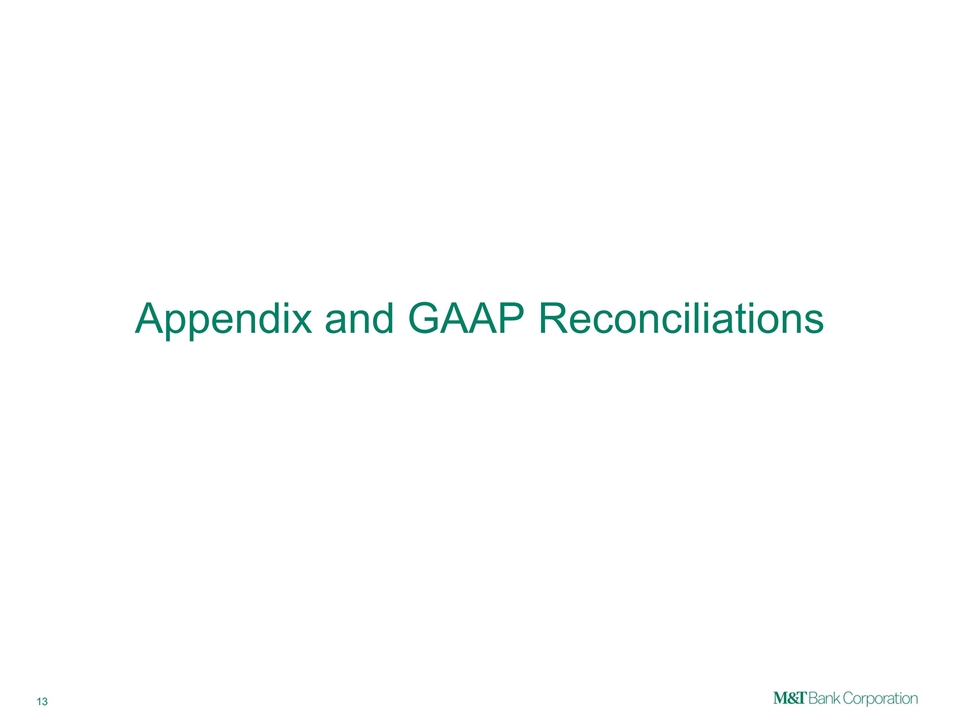
Appendix and GAAP Reconciliations
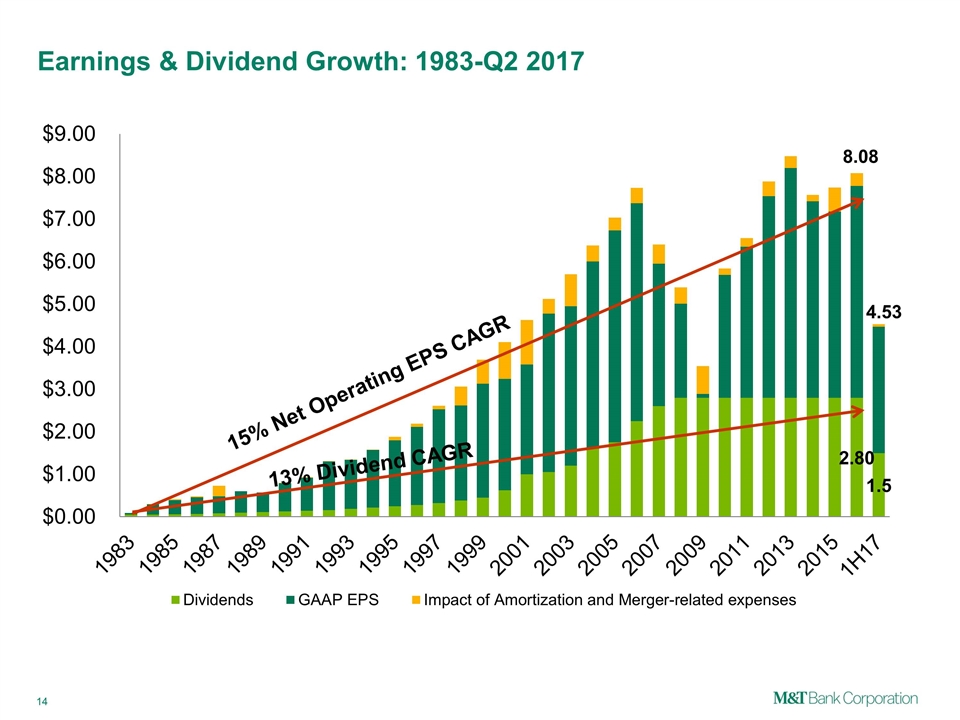
Earnings & Dividend Growth: 1983-Q2 2017 15% Net Operating EPS CAGR 13% Dividend CAGR
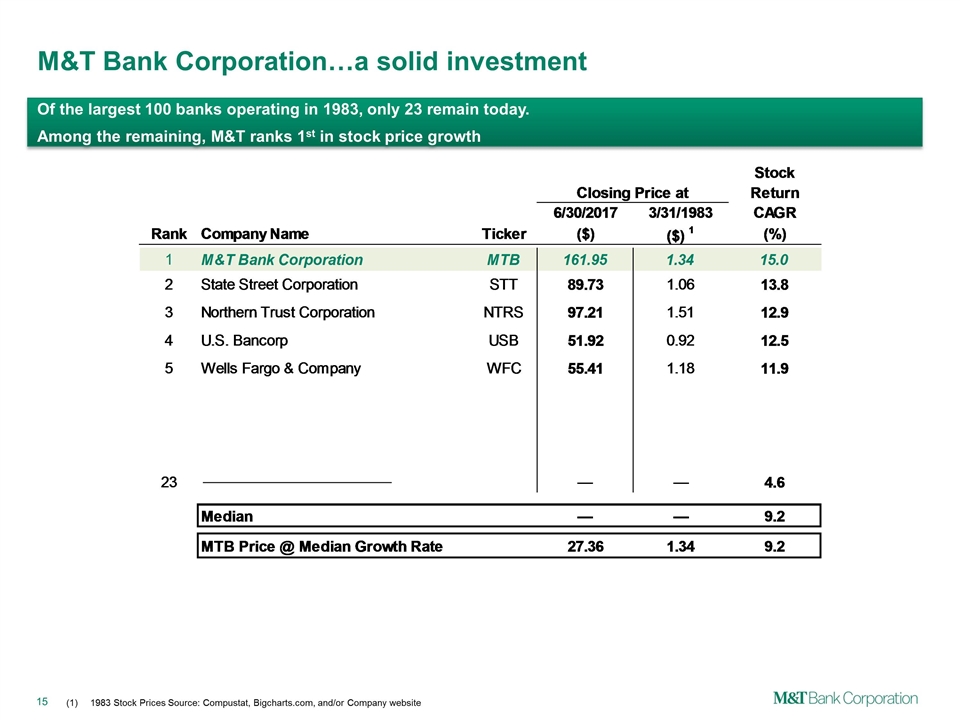
Of the largest 100 banks operating in 1983, only 23 remain today. Among the remaining, M&T ranks 1st in stock price growth M&T Bank Corporation…a solid investment 1983 Stock Prices Source: Compustat, Bigcharts.com, and/or Company website
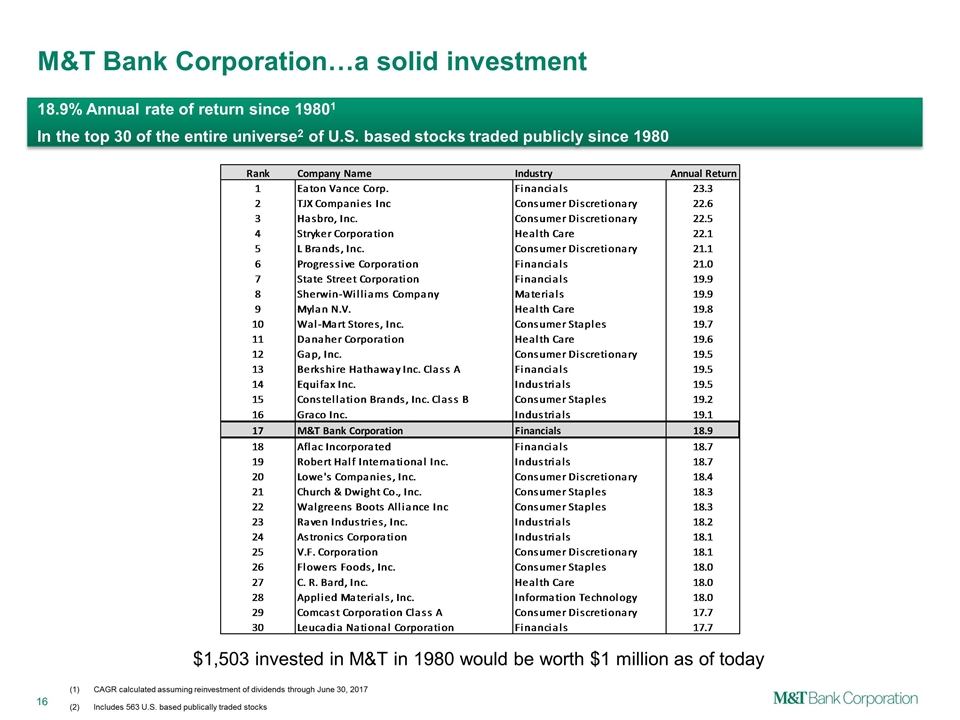
18.9% Annual rate of return since 19801 In the top 30 of the entire universe2 of U.S. based stocks traded publicly since 1980 M&T Bank Corporation…a solid investment CAGR calculated assuming reinvestment of dividends through June 30, 2017 Includes 563 U.S. based publically traded stocks $1,503 invested in M&T in 1980 would be worth $1 million as of today
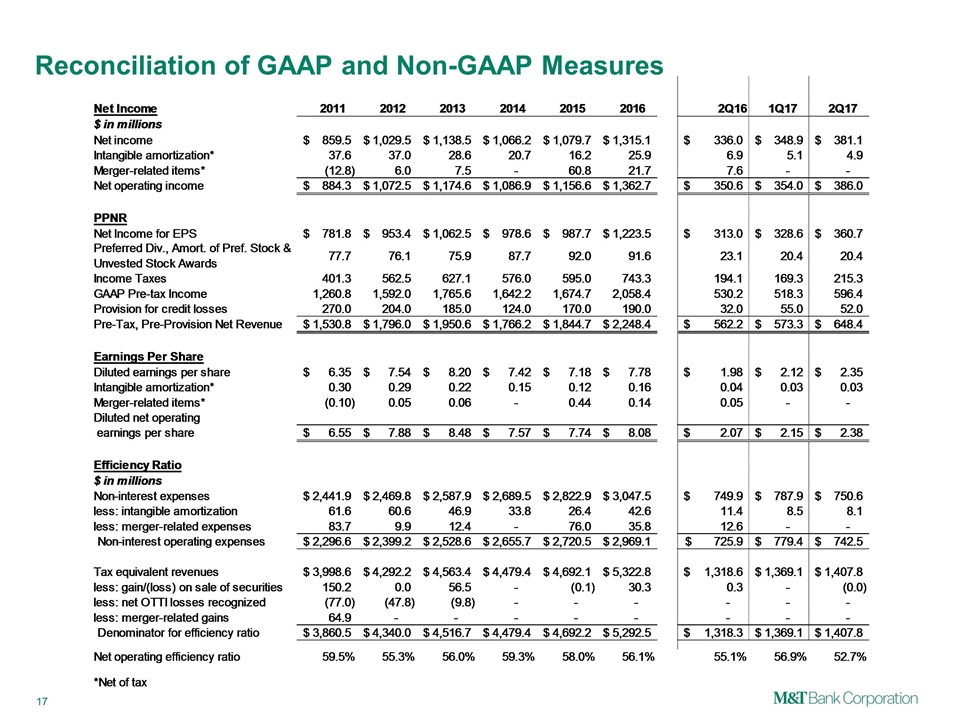
Reconciliation of GAAP and Non-GAAP Measures
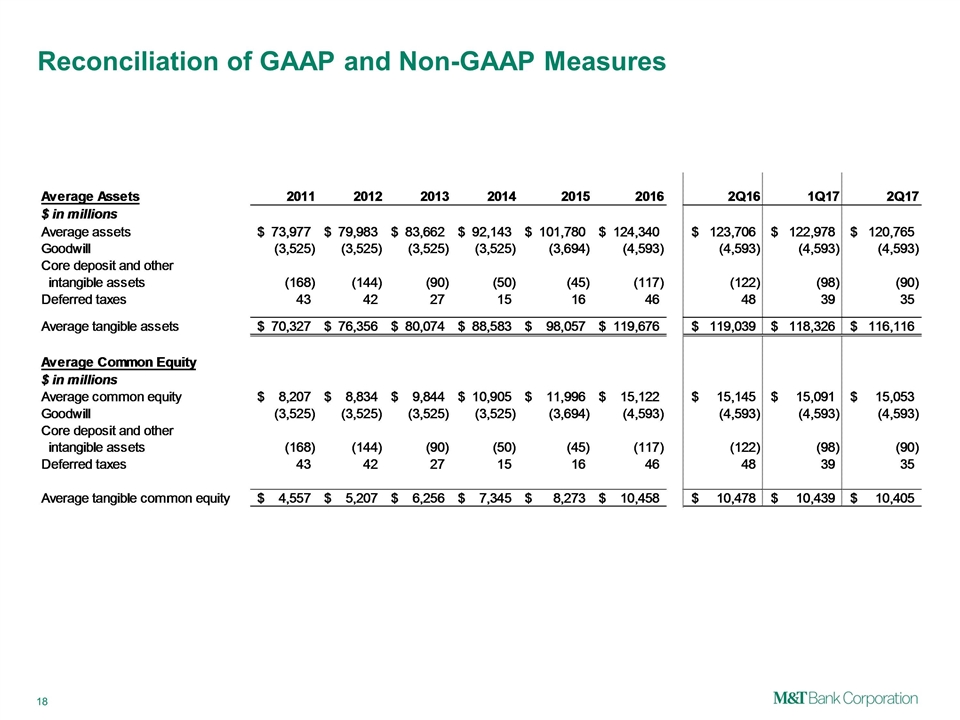
Reconciliation of GAAP and Non-GAAP Measures
